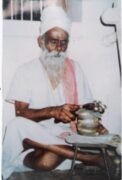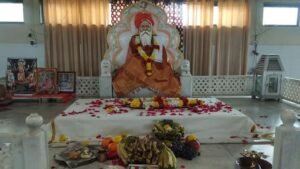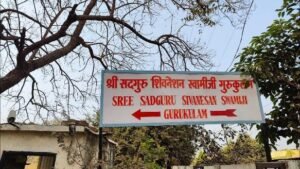
Beloved Children,
Om Namo Sainathaya
A Group of young children who had come to Shirdi requested the SAI AURA team to take them to the ‘Samadhi Sthal of Sivanesan Swamiji at Zarine’s farm 5 km from Shirdi off Pimpalwadi Road. We hired a van, and it was a blissful trip.
On reaching the Samadhi Sthal and the Ashram we were received by a monk Swami Sankara who took care of our needs and showed us the Ashram.
Sivanesan Swamiji Maharaj was 26 years old in 1953 and he was offered a small job as a housekeeping staff. He did not stir out of Shirdi and attained Maha Samadhi on 12th February 1996.
 As we went around the Ashram, we saw many rat holes and the children started a discussion about the rescue of forty-one workers, trapped for 17 days in November 2023. in an under-construction tunnel that collapsed due to a landslide in Uttarakhand’s Silkyara tunnel. The SAI AURA team felt that the children could at this point pick some wisdom that the incident inspires all.
As we went around the Ashram, we saw many rat holes and the children started a discussion about the rescue of forty-one workers, trapped for 17 days in November 2023. in an under-construction tunnel that collapsed due to a landslide in Uttarakhand’s Silkyara tunnel. The SAI AURA team felt that the children could at this point pick some wisdom that the incident inspires all.
The children knew that the best team, drawn from multiple agencies and globally reputed domain experts, brainstormed and planned the rescue operation. The fact that the operation involved not just rocks and debris, but human lives, made it sensitive and challenging. The best technology and the best equipment available were deployed. The US-made auger machine considered a state-of-the-art driller, was tasked to needle through the debris of a pipeline to improvise an escape way. The machine did as well as it could and went as far as it could. But the last mile, the last pipe, posed problems. Technology and machinery failed and bowed out. The rescuers were at their wit’s end. At last, who did they turn to? Rat-hole miners – the poorly paid, manual workers who are skilled in burrowing in narrow spaces and rocks, using handheld tools.
And what a feat these rat-hole miners accomplished!
This brings to mind what the Hindi poet, Rahim, said. In a popular Doha, Rahim cautions that things grand should not blind us to shun things small and lowly. To drive home his point, he posits a rhetorical question: where a needle is needed, he asks, can a sword serve instead? The sword may have its brave use, but so does the tiny needle. The sword is not superior to the needle; nor is the needle inferior. Each is unique.
things grand should not blind us to shun things small and lowly. To drive home his point, he posits a rhetorical question: where a needle is needed, he asks, can a sword serve instead? The sword may have its brave use, but so does the tiny needle. The sword is not superior to the needle; nor is the needle inferior. Each is unique.
The terms superior and inferior are not absolute. They are relative; related to the need of the moment and their ability to serve that specific need. This truth extends to all worldly assets and all social positions. To miss this point, to get embroiled in false notions of importance, leads us to a muddled value system and consequent miseries, on personal and social planes.
 From the mightiest emperor down to the tiniest blade of grass, everyone and everything has a specific function in life and is invested with a caliber tailored to this end. Emerson has a poem titled The Mountain and the Squirrel. The two quarreled. The mountain, in pride, called the squirrel, ‘Little Prig’. The squirrel coolly retorted: “True, I am not so large as you, but nor are you so small as I.”
From the mightiest emperor down to the tiniest blade of grass, everyone and everything has a specific function in life and is invested with a caliber tailored to this end. Emerson has a poem titled The Mountain and the Squirrel. The two quarreled. The mountain, in pride, called the squirrel, ‘Little Prig’. The squirrel coolly retorted: “True, I am not so large as you, but nor are you so small as I.”
The squirrel elaborated on its point: “Talents differ; all is well and wisely put; If I cannot carry forests on my back, neither can you crack a nut.” The auger machine could do big deeds, but not what the rat-hole miners did. The rat-hole miners, again, could not have done what the machine did. The poem states: “All sorts of things and weather/ Must be taken in together/ To make up a year/ And a sphere.” Hence, a thousand names for God!
Vishnu, the name, connotes The All. Two other names relevant to our context that appear one after the other in Vishnu Sahasranama, are Anu, 835, connoting the smallest and subtlest; and Brhat, 836, connoting the immeasurably large. Both are on a par. And wherever you are between these two extremes, that too is perfectly fine. As the squirrel declares: “I think it is no disgrace/ To occupy my place.”
Yours SAI BABAly
Sai Aura Team

Leave a Reply